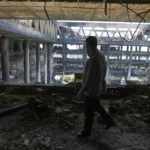
Couple convicted of ‘encouraging corruption and public prostitution’ after video of dance at landmark tower went viral
An Iranian court has handed jail sentences of more than 10 years each to a young couple who danced in front of one of Tehran’s main landmarks in a video seen as a symbol of defiance against the regime, activists have said.
Astiyazh Haghighi and her fiance, Amir Mohammad Ahmadi, both in their early 20s, were arrested in early November after a video went viral showing them dancing romantically in front of the Azadi Tower.
Haghighi was not wearing a headscarf, in defiance of Iran’s strict rules. Women are also not allowed to dance in public, let alone with a man.
A revolutionary court in Tehran sentenced them each to 10 years and six months in prison, as well as imposing bans on using the internet and leaving Iran, the US-based Human Rights Activists News Agency (HRANA) said.
The couple, who already had a following in Tehran as popular Instagram bloggers, were convicted of “encouraging corruption and public prostitution” as well as “gathering with the intention of disrupting national security”, it said.
HRANA cited sources close to their families as saying they had been deprived of lawyers during the court proceedings, and attempts to secure their release on bail had been rejected.
It said Haghighi was now in Qarchak prison for women, outside Tehran, whose conditions are regularly condemned by activists.
Iranian authorities have clamped down severely on all forms of dissent since Mahsa Amini’s death in September. The death of Amini, who had been arrested for allegedly violating the headscarf rules, sparked protests that have turned into a movement against the regime.
At least 14,000 people have been arrested, according to the United Nations, ranging from prominent celebrities, journalists and lawyers to ordinary people who took to the streets.
The couple’s video had been hailed as a symbol of the freedoms demanded by the protest movement, with Ahmadi at one moment lifting his partner in the air as her long hair flowed behind.
One of the main icons of the Iranian capital, the futuristic Azadi (Freedom) Tower is a place of huge sensitivity. It opened under the rule of the last shah, Mohammad Reza Pahlavi, in the early 1970s, when it was known as the Shahyad (In Memory of the Shah) Tower.
It was renamed after the shah was ousted in 1979 with the creation of the Islamic republic. Its architect, a member of the Bahá’í faith, which is not recognised in today’s Iran, now lives in exile.













 Posted in
Posted in 











